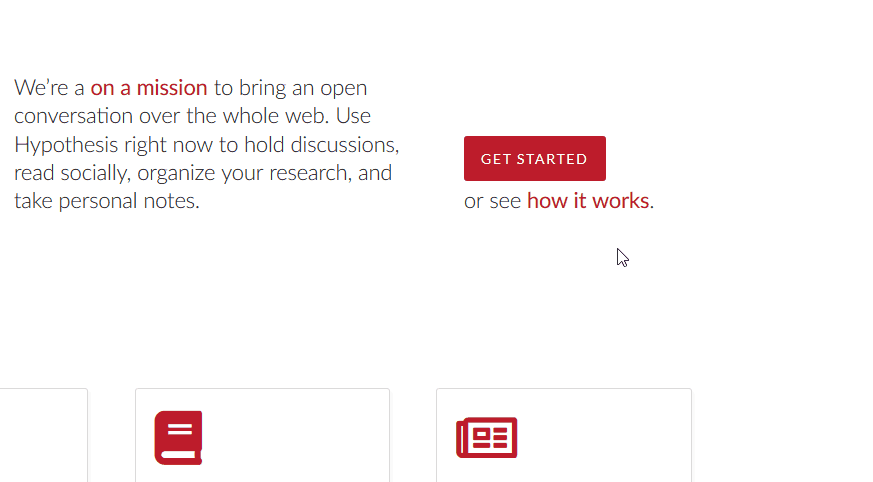Hypothes.is is an online social annotation tool. It allows users to annotate openly on websites, blogs, online journals, and news articles. Hypothes.is allows users to create groups to share online text, resources, links, and annotations. It can be used as a private note-taking and critiquing tool or a collaborative annotation tool. Using the Chrome Extension or bookmarklet (bookmark with JavaScript), users can annotate directly on a webpage or online text.

Hypothes.is Overview
Using Hypothes.is, traditional annotation activities (typically done in isolation) are transformed into collaborative knowledge-building activities. With public Hypothes.is pages, students can see annotations and comments by other individuals, including their peers and even experts in the field, and add their own annotations and comments that build on what they learned from others while reading a digital text (see examples of public Hypothes.is pages). Online class materials can be annotated in advance to lead to deeper, richer discussions during class time. A really exciting way to use Hypothes.is is to organize a “flash mob annotation” for topic of interest. This establishes a community of practice driven by interest and curiosity. During a flash mob annotation, participants meet online at a specific time, and simultaneously annotate a document or image, creating an exciting conversation.
Institutions can integrate Hypothes.is with their Learning Management Systems (LMS). For the duration of 2020, in support of institutions confronting the Covid-19 crisis, fees are being waived.
Tool Snapshot
| Price | Free for individual use. Paid plans for institutional use. |
|---|
| Learning | Social constructivism, Connectivism |
|---|
| Ease of Use | ★★★★☆ |
|---|
| Privacy | ★★★☆☆ |
|---|
| Accessibility | ★★★☆☆ (VPAT Report) |
|---|
| Class Size | Not Applicable |
|---|
| Login | Yes |
|---|
| ISTE*S | Knowledge Constructor, Global Collaborator |
|---|
COPPA/
FERPA | Yes, when a LMS (Learning Management System) app is used. No, when a non-LMS version is used (for personal use). |
|---|
| GDPR | Yes |
|---|
Ease of Use
The user can quickly learn how to use the tool with relative ease. There are tutorials and FAQ information available if the user runs into an issue with the tool.
Privacy
The user has to share some personally identifiable information (e.g., email address, name, location) when creating an account. The privacy policy clearly states how the information is used or shared. However, when the application is used through an institution’s LMS, the system is COPPA and FERPA compliant.
Hypothes.is Overview Video
 Watch on YouTube
Watch on YouTube
Video Transcription
Hypothes.is & the SAMR Model
Dr. Ruben Puentedura’s SAMR model offers a lens for examining how technology is adopted in a classroom. As you strive to incorporate online tools into your classroom, we encourage you to use this model as an analytic tool.
Here is an example of how Hypothes.is might fit within the SAMR model:
- Substitution: Students read and annotate text online instead of on a hard copy.
- Augmentation: The instructor annotates a class digital text ahead of time on Hypothes.is to guide students’ thinking, annotations, and comments.
- Modification: Students engage in annotating and discussing articles with peers outside of class time. Students critically analyze the archive of the annotations and discussions for a text.
- Redefinition: Students engage in collaborative annotating with experts and professionals from around the world.
Learning Activities
Math
- Annotate news articles to identify math in everyday life.
- Annotate the charts and graphs in news articles.
- Critique the credibility of Wikipedia pages about famous mathematicians.
Science
- Facilitate an open Hypothes.is discussion on a science article of interest.
- Use Hypothes.is to annotate media/news articles to evaluate the credibility and accuracy of scientific studies.
English/Language Arts
- Synthesize observations on a popular English poet’s work, referring to highlighted texts and collective annotations.
Social Studies
- Read two versions of a historical event and compare and contrast the two versions, including their accuracy and what the differences might mean in terms of the viewpoints of the writers.
Other
- Collect articles with divergent opinions or solutions and discuss with others the rationale underpinning the divergence in ideas.
Resources
How to Use Hypothes.is
Go to web.hypothes.is/start (Note: Hypothesis is only available on a computer) and click “Get Started.”

Create a new account.

After your create the account, install the Chrome extension. (Note: If you are not using Google Chrome, install the “bookmarklet.”)

You are now ready to annotate. Start by visiting any website and by selecting any text, and then by clicking “Annotate.”

A Hypothes.is window slides out from the right side of your screen to input your annotation comments.

That’s it! All your annotations, highlights and notes are now saved to your Hypothes.is account. You can find them by visiting https://hypothes.is anytime.
Research
Bonn, M., & McGlone, J. (2014). New feature: Article annotation with Hypothes.is. Journal of Electronic Publishing, 17(2). http://dx.doi.org/10.3998/3336451.0017.201
Kennedy, M. (2016). Open annotation and close reading the Victorian text: Using Hypothes.is with students. Journal of Victorian Culture, 21(4), 550-558. https://doi.org/10.1080/13555502.2016.1233905.
Authors
This page was created by Constance M. Cook and Sai Satish Gattupalli.